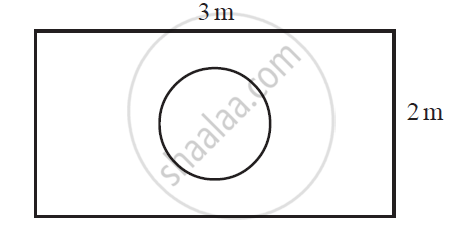Advertisements
Advertisements
Question
A circle with diameter 20 cm is drawn somewhere on a rectangular piece of paper with length 40 cm and width 30 cm. This paper is kept horizontal on table top and a dice, very small in size, is dropped on the rectangular paper without seeing towards it. If the dice falls and lands on the paper only, find the probability that it will fall and land inside the circle.
Solution
Diameter of the circle = 20 cm
Radius = 10 cm
Area of circle = πr2
= `22/7 xx 10 xx 10`
= `2200/7 cm^2`
Length of paper = 40 cm
Width of paper = 30 cm
Area of paper = 1200 cm2
Total possible outcomes = area of rectangular paper
Since paper is kept on table top and dice falls and land on paper.
Number of favorable outcomes = area of circle.
P(inside the circle) = `"Area of circle"/"Area of rectangular paper"`
= `(2200/7)/1200`
= `11/42`
APPEARS IN
RELATED QUESTIONS
Suppose you drop a die at random on the rectangular region shown in the given figure. What is the probability that it will land inside the circle with diameter 1m?

Are the arguments in the following sentence correct or not correct? Give a reason for your answer.
If two coins are tossed simultaneously there are three possible outcomes, two heads, two tails or one of each. Therefore, for each of these outcomes, the probability is `1/3.`
A bag contains 4 red, 5 black and 6 white balls. A ball is drawn from the bag at random. Find the probability that the ball drawn is Red
Find the probability that a number selected at random from the numbers 1, 2, 3, ..., 35 is a Multiple of 7
A bag contains twenty Rs 5 coins, fifty Rs 2 coins and thirty Re 1 coins. If it is equally likely that one of the coins will fall down when the bag is turned upside down, what is the probability that the coin will be a Re 1 coin?
Three coins are tossed together. Write all the possible outcomes. Now, find the probability of getting exactly two heads.
The probability of getting exactly one head in tossing a pair of coins is ____________.
Two dice are thrown at the same time. Find the probability of getting different numbers on both dice.
Read the following passage:
|
"Eight Ball" is a game played on a pool table with 15 balls numbered 1 to 15 and a "cue ball" that is solid and white. Of the 15 numbered balls, eight are solid (non-white) coloured and numbered 1 to 8 and seven are striped balls numbered 9 to 15.
|
Based on the above information, answer the following questions:
- What is the probability that the drawn ball bears number 8?
- What is the probability that the drawn ball bears an even number?
OR
What is the probability that the drawn ball bears a number, which is a multiple of 3? - What is the probability that the drawn ball is a solid coloured and bears an even number?
An unbiased die is thrown. The probability of getting an odd prime number is ______.

